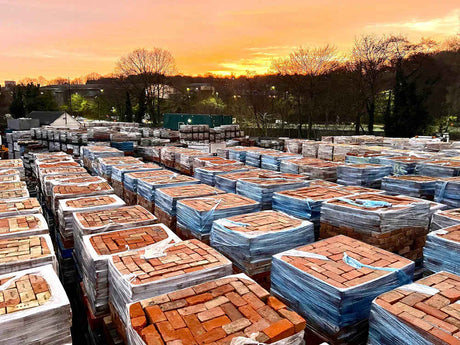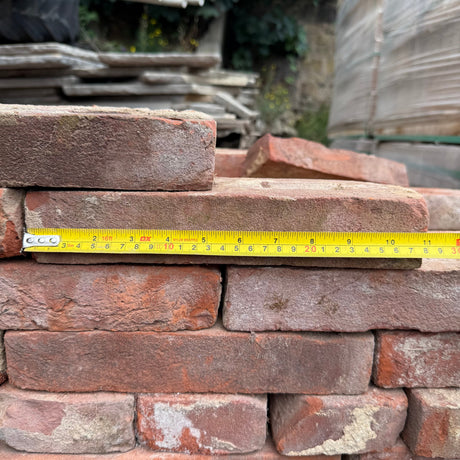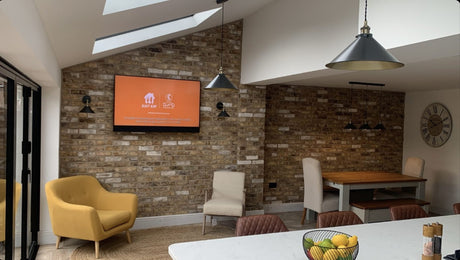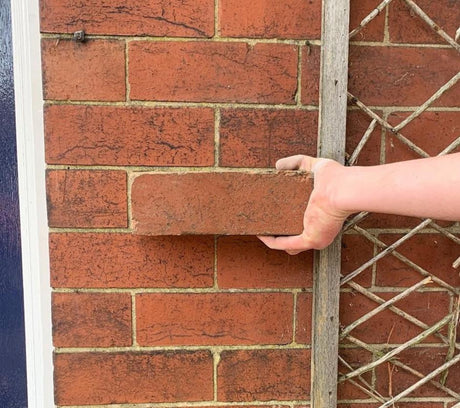Revamping your outdoor space can sometimes feel like a puzzle. You want it to be both practical and stylish. One creative solution is using railway sleepers as decking. This idea combines durability with rustic charm, offering a unique twist to traditional garden designs.
Railway sleepers are known for their strength and versatility, making them perfect for creating a robust decking area that withstands foot traffic and the elements. In this blog, we'll guide you through how to transform your patio or garden into an eye-catching feature using these sturdy materials.
Ready? Let’s explore together how railway sleepers can elevate your outdoor living space.
Why Choose sleeper Decking?
Choosing sleeper decking for your outdoor space offers several benefits that appeal directly to architects, builders, contractors, interior designers, and homeowners. Sleepers provide a rustic look while ensuring durability and strength.
Using railway sleepers as decking boards adds character through their unique texture and appearance. These timber elements can withstand harsh weather conditions, offering longevity.
They are perfect for creating raised decks, adding a new dimension to gardens or landscapes.
Sleeper decking projects stand out because they allow the use of reclaimed materials, supporting sustainability efforts. Reclaimed sleepers come with a history that adds an extra layer of interest to any project.
Whether you opt for new railway sleepers or recycled ones, this choice contributes positively to reducing waste in the environment. Moreover, both hardwood and softwood options offer flexibility in design while meeting various budgetary considerations.
Sleeper decks require regular maintenance but reward you with an eye-catching outdoor area suitable for multiple uses – from seating areas to garden edging.
What Are the Benefits of Railway Sleeper Decking?
Railway sleeper decking offers a unique blend of durability and aesthetic appeal, making it a popular choice for many homeowners, and professionals like architects and builders. These sleepers are great for creating an outdoor space with a rustic, yet modern look.
They're highly resistant to wear, handling heavy foot traffic with ease. This robustness ensures the railway sleeper deck lasts for years, facing off against elements like rain and sun without losing its character.
Using sleepers to build your deck also opens up creative ways to design your garden or outdoor area. You can fashion anything from steps to seating areas, integrating seamlessly with both traditional and contemporary landscapes.
The versatility of garden sleepers means they fit various themes and settings, whether you're looking to enhance a London townhouse's lawn or craft a cosy nook in a rural backyard.
Opting for railway sleepers makes maintaining these areas simpler, as their solid structure needs minimal care compared to conventional decking materials.
How Durable Are Sleepers for Decking?
Sleepers for decking show remarkable durability, lasting up to 20 years if properly manufactured, treated and maintained. These sturdy materials, often used on railway tracks, are built to withstand heavy loads and harsh weather conditions.
New sleepers that have been pressure-treated can resist rot and pests for many years. On the other hand, reclaimed railway sleepers might already have a history of exposure but can still provide robust support when selected carefully.
Using these sleepers makes your deck not just strong but also adds a rustic charm. The choice between new or reclaimed depends on your project's look and environmental considerations.
Each type has its benefits for different designs and purposes in landscaping projects. Now let's explore whether reclaimed sleepers can be used effectively for decking projects.

Can Reclaimed Sleepers Be Used?
Reclaimed sleepers discover a new purpose in garden projects, demonstrating that both beauty and strength are achievable. Numerous professionals suggest using recovered railway sleepers for decking owing to their resilience and unique charm.
They have weathered conditions next to railway lines, earning a robustness that renders them perfect for outdoor applications such as decks, retaining walls, and garden borders. It's also worth mentioning that these sleepers are frequently treated with creosote to maintain resistance to rot and pests.
Nevertheless, it’s crucial to cautiously manage creosote-treated wood during assembly.
Think about reclaimed sleepers as a green option that maintains an equilibrium between strength and aesthetics.
Builders and landscapers appreciate recovered timbers for their historical allure and environmental advantages; they lower the need for fresh timber resources from sustainable forests while offering a sturdy material appropriate for various uses.
During the selection of reclaimed sleepers, closely examine them to avoid ones with excessive wear or damage. This thoughtful choice ensures your deck maintains a unique appeal but also resists weathering and wear over time.
How to Use Railway Sleepers for Your Deck
Building a deck with railway sleepers introduces a touch of charm and warmth to any outdoor setting. Initially, you must choose between new or reclaimed railway sleepers. New ones offer a consistent appearance, whereas reclaimed ones possess a unique charm, albeit potentially complicated by differing sizes.
To establish a sturdy foundation, it is crucial to spread a layer of sand or concrete beforehand. This action keeps the stone sleepers from ground moisture contact, which may cause decay.
For the creation of your sleeper deck, position the sleepers on the ground level of prepared base evenly. Make sure they're flat and secure with landscaping screws or bolts for firmness. If a raised deck design is preferred, it becomes necessary to construct a frame supporting the sleeper's weight and preserving structural rigidity.
It's important to apply the appropriate treatment to wooden sleepers before installing them, particularly if they are untreated softwood that can degrade when exposed.
Next, we'll discuss which sleepers are most suitable for your decking project.
Steps to Build a Sleeper Deck
Building a sleeper deck can transform your outdoor space into an inviting retreat. It requires careful planning and execution. Here's how you can achieve this:
-
Measure your area to determine the number of sleepers you’ll need. The size of sleepers typically ranges from 2.4m to 4m, allowing you to calculate based on the area coverage.
-
Choose the right type of sleepers for your project. Options include new railway sleepers, reclaimed railway sleepers, hardwood, and softwood. Consider oak sleepers for their durability and aesthetic appeal.
-
Prepare the ground where you plan to build your deck. Ensure it’s level and clear of weeds and debris. Use a weed barrier fabric to prevent future growth under your deck.
-
Create a solid foundation if you're not placing the sleepers directly on soil. This might involve laying concrete pads or compacted gravel.
-
Plan the layout of the sleepers by positioning them in the intended design before fixing them together. This step helps visualise the end result and adjust as needed.
-
Cut the sleepers to fit your design if required using a chainsaw or handsaw, bearing in mind that accurate cuts are crucial for a clean finish.
-
Attach a frame or base to place your sleepers on if elevation is desired or necessary for drainage reasons—a critical step in ensuring longevity and stability.
-
Place the sleepers on top of the frame or directly on the prepared ground, depending on your chosen method.
-
Secure each sleeper in place by drilling holes through them into your foundational material (ground, gravel, concrete) and use appropriate fixings like screws designed for outdoor use.
10.Treat all cut ends of timber with a preservative to protect against rot and pests especially if using untreated wood.
11.Finish by treating the entire deck with a weatherproofing product suitable for your chosen type of wood, providing protection from water damage and sun exposure.
12.Regular maintenance involves checking for any loose screws or damaged sections that need replacing over time to keep it tidy and safe.
These steps guide you through building a durable sleeper deck that enhances any garden landscape while offering practical outdoor living space.
Next, we explore whether builders should construct frames under decking areas.

Do You Need to Build a Frame?
After laying out the steps for building a sleeper deck, a crucial question arises: do you need to build a frame? The straightforward answer is yes. Constructing a solid frame provides essential support and ensures that the sleepers are positioned correctly for long-lasting durability.
This frame acts as the skeleton of your house and decking, bearing the load and providing stability against movements due to soil conditions or weather changes.
A well-built frame is foundational to achieving a durable and stable deck.
For architects, builders, contractors, interior designers, and DIY enthusiasts aiming to use railway sleepers in their outdoor space transformation projects, crafting a robust framework is not just beneficial—it's necessary.
Using pressure-treated timber for framing helps prevent rot and extends the lifespan of your deck significantly. Plus, securing your framework with 100mm screws creates an anchored base that keeps everything in place over time.
It’s paramount for ensuring safety and adding value to any outdoor living area.
How to Position Sleepers for Decking
Positioning sleepers for decking requires precision and understanding of the space. This helps architects, builders, contractors, interior designers, and homeowners create a durable and aesthetically pleasing deck.
-
Measure the area where you plan to install the decking. Ensure accuracy as this determines how many sleepers you’ll need.
-
Clear the ground and level it before laying sleepers down. This prevents water from pooling under your deck.
-
Place a weed membrane under where the sleepers will lie to stop weeds from growing through your deck.
-
Start by laying sleepers around the perimeter of your designated area. This creates a solid frame for your decking.
-
Use spirit levels to ensure all sleepers are flat and level with each other. Consistency here is key to avoid a sloped deck.
-
For extra stability, lay sleepers in a perpendicular or parallel pattern across the entire area within your frame.
-
Leave gaps between each sleeper for water drainage; typically, 5mm to 10mm is adequate to prevent water logging.
-
If using new railway sleepers, treat them before positioning to extend their lifespan against rot and insect damage.
-
For reclaimed railway sleepers, inspect each piece for suitability—avoid those with excessive damage or creosote levels that could seep out.
-
Secure sleepers together using suitable outdoor screws or bolts that won’t rust over time.
-
Consider installing a balustrade around your sleeper deck if it’s elevated or if you prefer an enclosed area for safety or privacy.
Following these steps ensures that architects, builders, contractors, interior designers, and homeowners can position their sleeper decking effectively, creating an inviting outdoor space ready for landscaping or furniture additions like benches or raised beds.
What Types of Sleepers Can Be Used?
Choosing the right type of railway sleepers for decking hinges on several factors, including aesthetic preferences, budget constraints, and the intended use. New railway sleepers offer a clean look and consistent dimensions, making them a popular choice for those seeking uniformity in their garden design.
They come treated to resist rotting and are apt for creating a modern outdoor space. On the other hand, reclaimed railway sleepers have character and history. These reused materials from old railroad tracks add unique charm to any project but require thorough inspection for wear and suitability.
Deciding between hardwood and softwood sleepers depends on your project's requirements. Hardwood varieties like oak are more durable and resistant to decay, suitable for areas exposed to the elements or where longevity is crucial.
Softwood options, such as pine, are lighter and easier to work with but may not last as long unless pressure treated. Ensure that the sleepers you buy new or reclaimed meet your needs in terms of resistance to weathering, aesthetics, and strength properties required for supporting larger areas or features like water features or raised beds.
Are New Railway Sleepers Better?
New railway sleepers offer several benefits for decking projects. They come treated and ready to resist rot, making them a durable choice. These sleepers ensure your front decking safe and remains in top condition for years.
Their uniform size aids in creating a smooth, even decking surface. This makes installation easier compared to reclaimed sleepers that may be irregular.
Using new railway sleepers means less preparation time and more enjoying your outdoor space.
Homeowners planning to use sleepers for their gardens appreciate the lack of guesswork with new materials. Builders find them reliable due to their consistent quality and strength.
For those concerned about safety, these sleepers are also treated to reduce becoming slippery, a common issue with garden decks.
What About Reclaimed Railway Sleepers?
Moving from new to reclaimed railway sleepers offers a sustainable option. Many architects, builders, and designers favour these for their unique character and history. They add distinctive charm to decking projects, blending seamlessly with both modern and traditional designs.
Reclaimed sleepers often come treated, extending their life in outdoor settings. This choice supports eco-friendly construction practices by repurposing materials that might otherwise go to waste.
Reclaimed sleepers pose certain challenges too. Each piece varies in size and condition, requiring thorough selection for your project. Some may have traces of creosote—a preservative—demanding careful handling and usage especially in spaces used by children or food production areas.
Despite these considerations, the robust nature of reclaimed timber makes it ideal for durable decking that stands the test of time while contributing to a circular economy.

How to Choose Between Hardwood and Softwood?
Transitioning from the topic of reclaimed railway sleepers, selecting between hardwood and softwood is essential for ensuring your decking suits your specific needs. Hardwoods, sourced from trees like oak or teak, offer remarkable durability and resistance to decay.
They often stand up better over time but tend to come with a higher price tag due to their slow growth rates. On the other hand, softwoods such as pine or spruce are more budget-friendly and widely available.
These types of wood typically undergo treatment processes to enhance their resilience against rot and pests which makes them suitable for outdoor use.
Choosing the right type of wood depends on various factors including budget, aesthetic preferences, and long-term maintenance considerations. Hardwoods provide a rich colour and texture that matures beautifully with age but will require a larger investment upfront.
Softwoods might need more frequent care like staining or sealing but can offer a cost-effective solution for those looking to create an attractive outdoor space without overspending.
Weighing these options carefully will help architects, builders, contractors, interior designers, and homeowners make informed decisions when using railway sleepers for decking projects.
Maintaining Your Railway Sleeper Deck
Keeping your railway sleeper deck at its best requires crucial timber treatment. Use a protective layer to repel moisture and avoid decay. This action prolongs their durability while preserving the aesthetic appeal of the wood.
For treated softwood sleepers, a tanalised solution every two to three years is sufficient to protect them from rot and pests.
Persistent care ensures continued charm and resilience for your deck.
The highest standard of decking surface maintenance demands regular cleaning. Make sure to rid the surface of leaves and debris to prevent moisture accumulation that could foster mould and mildew.
Conduct an annual check-up of your deck to detect any wear or damage. Strengthen any weak screws, plates or nails, and change any worn-out sleepers without delay to maintain the structural strength.
Adhering to this procedure is extremely beneficial to prolonging the lifespan of your distinct outdoor area made with railway sleepers.
How to Treat Timber Sleepers?
Treating timber sleepers properly extends their life and maintains the beauty of your timber decking and (building). This ensures they resist rot, pests, and weather elements effectively.
-
Choose the right treatment: Pick a wood preservative that fits the sleeper type—hardwood or softwood. For hardwood, opt for a light oil-based product. Use a more heavy-duty preservative for softwoods.
-
Clean the sleepers: Before applying any treatment, ensure they are clean. Use a brush to remove dirt and debris.
-
Apply preservative: Wear gloves and use a brush to apply the wood preservative evenly on all sides of the sleeper. Make sure you cover end grains thoroughly as they absorb more moisture.
-
Let it dry: Allow the treated sleepers to dry completely before installing them or walking on them.
-
Regular maintenance: Inspect your timber sleepers annually for signs of wear or damage. Reapply preservative every two to three years depending on exposure to elements.
-
Keep them clean: Sweep your deck regularly to keep debris from trapping moisture against the wood.
-
Manage vegetation: Ensure plants and shrubs do not directly touch your deck as this may promote rot.
-
Seal ends if cut: If you need to trim your railway sleepers, seal the cut ends with an end-grain preserver to maintain protection against moisture ingress.
-
Consider a top coating: For extra resilience, consider applying a decking oil or stain after the preservative has dried fully, enhancing both appearance and protective qualities.
-
Follow manufacturer instructions: Always read and follow the guidance provided by your chosen treatment product's manufacturer for best results.
Following these steps helps safeguard your investment in railway sleeper decking, ensuring it remains strong, durable, and visually appealing for years depending on its exposure to outdoor conditions.
What Are the Best Practices for Decking Surface Care?
Regular cleaning forms the cornerstone of decking surface care. Homeowners and builders should schedule cleanings at least twice a year to prevent dirt accumulation. Using a soft brush, they can remove debris from between the sleepers.
This step is crucial for maintaining both appearance and safety. A mild detergent in water often suffices for removing stains without damaging the wood's integrity.
For deeper protection, treating timber sleepers with a suitable preservative extends their lifespan significantly. It guards against rot, insects, and weather damage. Specialists strongly recommend applying these treatments immediately after installation and then routinely every two years.
Selecting products specifically designed for outdoor use ensures compatibility with your sleeper material—be it hardwood or softwood—and enhances durability against the elements over time.
Additional Uses for Garden Sleepers
Garden sleepers offer flexible solutions beyond traditional decking. Architects and homeowners can construct raised beds with sleepers to create distinct areas for planting vegetables or flowers.
This method elevates the garden, making it easier to manage and adding an aesthetic appeal. Builders use sleepers for garden edging as well, defining pathways and separating different sections of outdoor spaces efficiently.
Innovative designs incorporate sleepers into fences, providing privacy while adding a rustic touch. Interior designers find creative ways to use them in outdoor furniture projects like benches or tables, integrating natural elements into the design.
Contractors recommend using hardwood sleepers for their durability in these projects. Each sleeper brings unique textures and colours, allowing for personalised touches in garden design that resonate with homeowners looking to enhance their outdoor living space.

How to Create Raised Beds with Sleepers?
Creating raised beds with sleepers offers a durable and aesthetically pleasing solution for your garden. This approach uses strong materials that can handle various wet weather conditions, making it ideal for growing a wide range of plants.
-
Choose the location for your raised bed carefully. Ensure it receives enough sunlight based on what you plan to grow.
-
Measure and mark out the area where you'll place the sleepers. Accuracy is key to achieving a neat finish.
-
Select suitable sleepers for your project. Consider reclaimed railway sleepers for an eco-friendly option or go for new ones if you prefer a cleaner look.
-
Cut the sleepers to your desired length using a saw. Keep measurements consistent for a uniform appearance.
-
Lay out the first layer of sleepers directly on the ground, following your marked outline.
-
Check that each sleeper is level using a spirit level. Adjust them as necessary by adding or removing soil underneath.
-
Stack additional layers of sleepers on top of the first, securing them together with landscaping screws or long nails.
-
If desired, line the inside walls of the raised bed with landscape fabric to prevent soil from escaping through gaps in the sleepers.
-
Fill your raised bed with a mix of topsoil and compost, ensuring nutrient-rich soil for whatever you're planning to plant.
-
Water the soil thoroughly before planting your seeds or seedlings.
-
Maintain your sleeper-raised beds by checking regularly for any signs of wear or rot in the wood and treat with wood preserver if required.
-
Enjoy planting and see what you've created flourish in your custom-made raised beds.
Can Sleepers Be Used for Garden Edging?
Indeed, sleepers prove to be an exceptional selection for garden edging. They deliver a solid and appealing border for gardens, demarcating diverse areas while supplementing a hint of pastoral allure.
Placing sleepers strategically around your garden clearly marks the area whilst also offering sturdiness and backing to soil beds. Their toughness makes them suitable for enduring outdoor conditions all through the year.
This usage is particularly beneficial in forming distinct separations between lawns, flowerbeds, or pathways without requiring persistent upkeep.
Shifting from practical applications to imaginative design possibilities, sleepers extend beyond mere practicality. They stimulate inventive landscaping ideas that significantly elevate outdoor aesthetics.
Ideas for Garden Design Using Sleepers
Moving beyond garden edging, sleepers serve as versatile tools for broader garden designs. Creating raised beds with sleepers allows plants to thrive by improving drainage and soil quality.
This method also helps prevent pests from reaching the plants. For a visual twist, stack sleepers in varying heights to form dynamic plant displays or seating areas for larger area. These structures can add depth and interest to any outdoor space.
Sleepers can also craft paths and walkways through your garden, guiding visitors on a journey around the area. Laying them side by side or in interesting patterns makes for an eye-catching feature that blends well with both modern and traditional settings.
With their sturdy nature, sleepers provide a durable solution that withstands foot traffic while integrating seamlessly into the landscape design.
Conclusion
Revamping your outdoor area with railway sleepers for decking fuses elegance with eco-friendliness. This approach is simple yet effective, enabling a distinct mix of quaint appeal and contemporary architecture.
Opting for either new or salvaged sleepers, be they hardwood or softwood, provides versatility in design without compromising resilience. Regular upkeep maintains the deck's aesthetics and prolongs its lifespan.
Venture on this journey to improve your garden; the influence on your outdoor recreation zone will be significant and gratifying.








